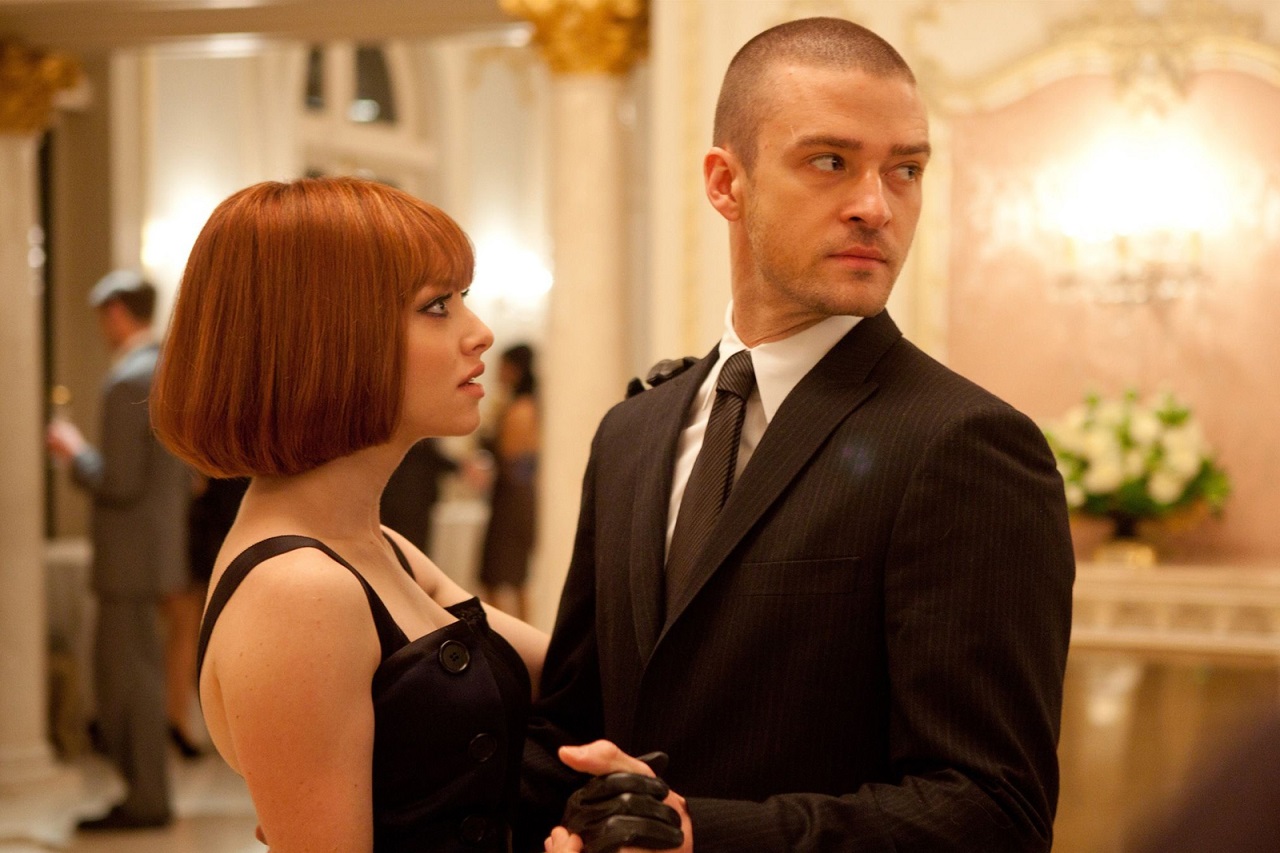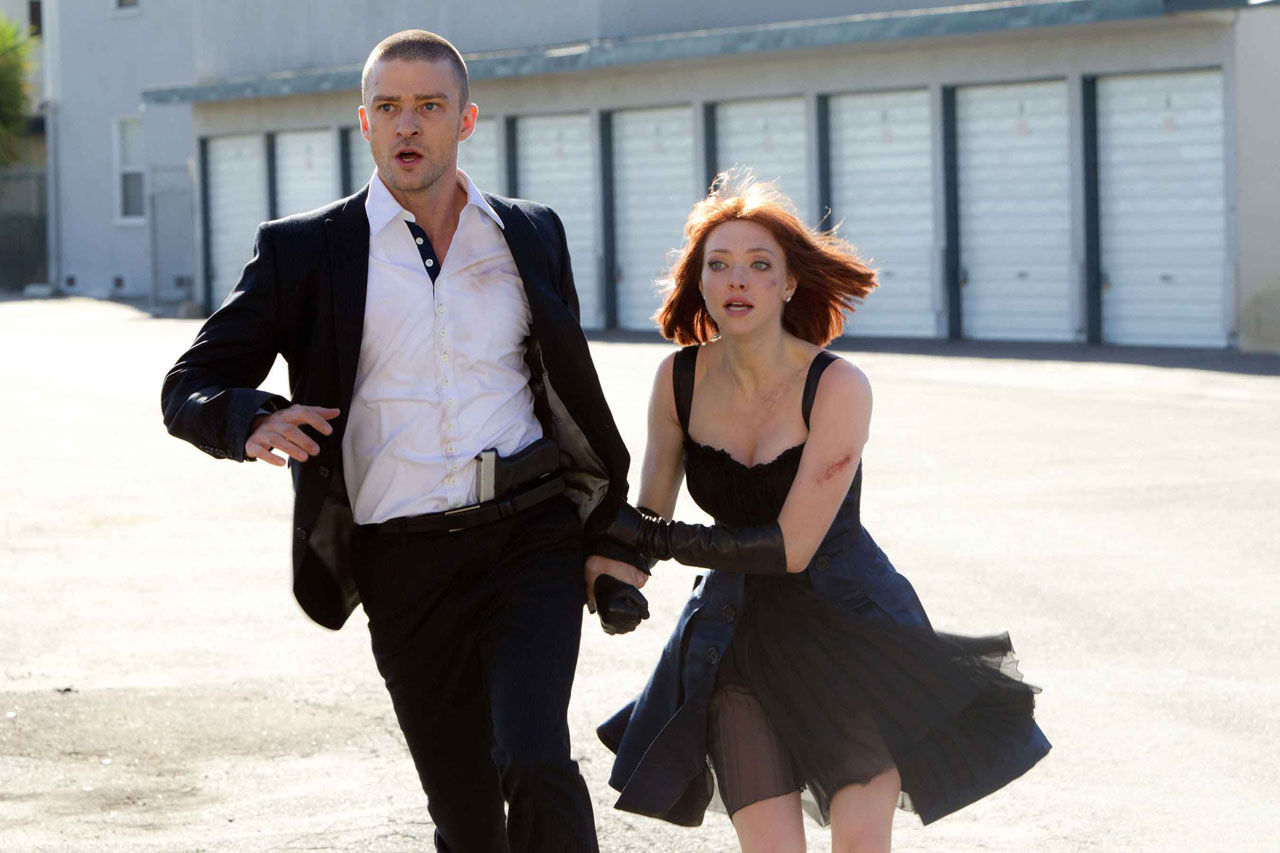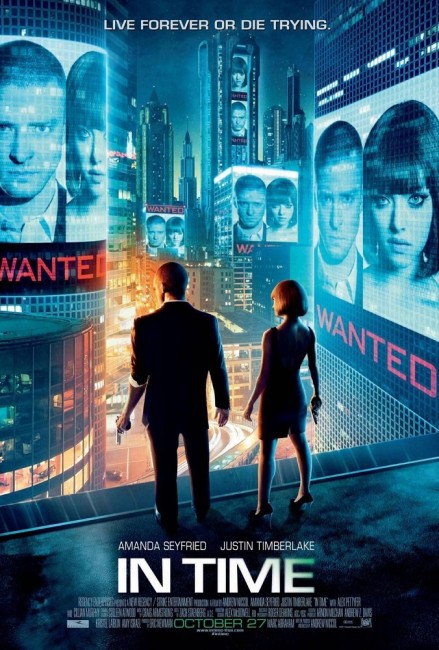USA. 2011.
Crew
Director/Screenplay – Andrew Niccol, Producers – Marc Abraham, Eric Newman & Andrew Niccol, Photography – Roger Deakins, Music – Craig Armstrong, Visual Effects Supervisor – Ellen M. Somers, Visual Effects – Luma Pictures (Supervisor – Payam Shohadai) & Soho VFX (Supervisor – Jorge Razon), Special Effects Supervisor – Matt Sweeney, Production Design – Alex McDowell. Production Company – New Regency/Strike Entertainment.
Cast
Justin Timberlake (Will Salas), Amanda Seyfried (Sylvia Weis), Cillian Murphy (Raymond Leon), Vincent Kartheiser (Philippe Weis), Alex Pettyfer (Fortis), Matt Bomer (Henry Hamilton), Olivia Wilde (Rachel Salas), Johnny Galecki (Borel), Yaya DaCosta (Greta)
Plot
In the future, everybody is genetically engineered to live to the age of 25. Thereafter, their bodies will die unless they can afford to pay for more time. As a result, time has become a currency by which everything is earned and paid, it being measured by a clock tattooed on people’s arms when they are born. Those who can afford to do so remain eternally youthful. On the opposite side of the coin, Will Salas is a construction-line worker who lives in the Dayton ghetto where most people can only afford to purchase enough time to live from day to day. In a bar, Will meets Henry Hamilton, a man from another time zone, the elite New Greenwich suburbs, who has more than a century on his arm. Hamilton has lost the will to live and become reckless. Will acts to save him from gangs that seek to steal his time and grants him shelter. When Will wakes, he finds that Hamilton has donated his century to him but is unable to stop him before his clock expires and he dies. Nor is Will in time enough to use his new years to save his mother as her clock runs out. Swearing vengeance, Will travels into the New Greenwich time zone. There he enjoys the lifestyle of the wealthy, winning more than a thousand years from tycoon Philippe Weis in a poker game. He is attracted to Weis’s daughter Sylvia who is bored with the privileged lifestyle that she was born into. Will is then arrested by Raymond Leon, a Timekeeper police officer investigating Hamilton’s death, but makes an escape, heading back into Dayton with Sylvia as hostage. At first they fight and steal to get enough minutes to stay alive but then come up with the idea of robbing the wealth accumulated by her father and redistributing it to the poor.
Andrew Niccol has become a director-writer whose cool and smartly intelligent work has pegged him as one of the names always worth watching out for. Niccol first appeared with the exceptional double slam of the dystopian future film Gattaca (1997) and the script for The Truman Show (1998). These showed the former New Zealander as a director-writer of enormous promise. This was not quite fulfilled in Niccol’s next directorial outing, the rather slight S1m0ne (2002) about a virtual Hollywood actress and the story for one of Steven Spielberg’s weakest films The Terminal (2004). However, Niccol sprang back to form with his finest work yet, the non-genre Lord of War (2005), a darkly acerbic work about the arms trade, and In Time here. Niccol subsequently signed on to direct the adaptation of Stephenie Meyer’s The Host (2013) about alien body snatchers; Good Kill (2014) about modern drone warfare; and Anon (2018) set in a mass-surveillance future.
In Time sees Andrew Niccol back in the same territory as Gattaca. In both films, he has a great deal of fun conceiving of a future society that is based around a single idea – a future where people are genetically perfected in Gattaca, where time has become a form of commerce here – and then does an amazing job in terms of exploring the conceptual possibilities of how such a system would operate and the flaws and loopholes that people would find. What shines through in Andrew Niccol’s films is the pure beauty of the logical extrapolation of the idea.
Compare Gattaca and In Time to other dystopian films such as Aeon Flux (2005), The Island (2005) and Repo Men (2010); by contrast to these, Niccol places a complete lack of focus on special effects or elaborate sets. While he does not entirely eschew visual effects, their placement is unobtrusive as opposed to showoffy. His films are low-tech, where design extends no further than coolly disquiet or shadowless lighting schemes and classic cars. The pleasure of the films lies entirely in the idea and the unfolding of it. Look no further than the way he disorients our assumptions from the opening scene as Justin Timberlake gets out of bed and wanders into the kitchen to greet Olivia Wilde “Morning Mom … Happy fiftieth.” The depth of social detail that such a nonchalant exchange offers about the world we have entered into is astonishing.

In Time is undeniably reminiscent of Logan’s Run (1976), a film that has been mentioned for a remake for the better part of a decade now. Both are films that are about futures where people are granted only a limited lifespan – in both there is the idea of the clock implanted on the arm, a digital readout on the wrist here, a crystal in the palm that changes colour in Logan’s Run. There is also something of the Joe Haldeman novel The Long Habit of Living (1989) in the idea of a future where immortality is something that must be purchased to be renewed, although In Time has a fierce originality all of its own.
Andrew Niccol also taps into a number of common dystopian themes – particularly the idea of the barbarian in Utopia whose unsophisticated roughness becomes something of appeal to people living a starchy detached life that we see in Aldous Huxley’s Brave New World (1932) and films such as Zardoz (1974), Buck Rogers in the 25th Century (1979) and Demolition Man (1993).
Andrew Niccol takes as his premise the fascinating idea of a future where time has become a unit of currency. Out of this, he creates a world where the wealthy live in a sphere of privilege where they have centuries and aeons to spare, while outside in the ghettos (referred to as Time Zones – Niccol takes delight in inventing new meanings for familiar time-based phrases) the poor eke out a pitiful existence struggling to get enough time to live from day to day. Niccol even goes so far as to accuse the rich of deliberately engineering the system to kill the poor off by constantly hiking prices.
Of course, when it comes down to it, this is Andrew Niccol delivering a blistering attack on no less than the entire capitalist system and taking up sides with the anger that has grown over the last couple of years at the way it has allowed a handful to steal a substantial part of the world’s wealth. Indeed, when Niccol gets to the scenes where Justin Timberlake and Amanda Seyfried take up arms and begin a Robin Hood campaign to redistribute the wealth to the poor of the world, In Time could almost be a manifesto intended for the crowds gathered at the Occupy Wall Street protests.

The great surprise about In Time is the very similar one that came with Avatar (2009). Both films are produced by 20th Century Fox, the corporation owned by Rupert Murdoch that also runs the Fox News Channel, a blatant propaganda arm for right-wing American Republicanism. Despite this, both Andrew Niccol and James Cameron have managed to sneak strongly leftist films out under the nose of Murdoch and Fox News by doing the old Star Trek (1966-9) trick of disguising their message as science-fiction. In James Cameron’s case, he snuck Avatar out as an ardently pro-environmentalist work by setting it on an alien planet with blue-skinned aliens, while Andrew Niccol has managed to make a blatantly Marxist film that offers a call to arms in terms of social revolution and advocates stealing from the rich simply by casting the story in the future and talking about time instead of money.
The idea of a film where everybody remains the perpetual age of twenty-five must have been one of irresistible appeal to Hollywood execs in allowing them to cast the film with young and handsome faces (even if some of the actors are well into their mid-thirties). In the last few years, teenage pop idol Justin Timberlake has been an actor on the rise in efforts ranging from the entirely lightweight – Shrek the Third (2007), Yogi Bear (2010) – to serious dramatic work in Black Snake Moan (2006) and The Social Network (2010) for which he has attained some reasonable acclaim. Here he acquits himself well as the hero of the show.
The increasingly rising Amanda Seyfried is entirely unrecognisable under a chestnut bob cut, a bubbly inflated figure in a mini-skirt and heels, and piercing blue eyes that give her the appearance of a porcelain doll. Cillian Murphy also plays with an admirably charismatic cool as the pursuing policeman nemesis.
(Winner in this site’s Top 10 Films of 2011 list. Nominee for Best Original Screenplay at this site’s Best of 2011 Awards).
Trailer here


